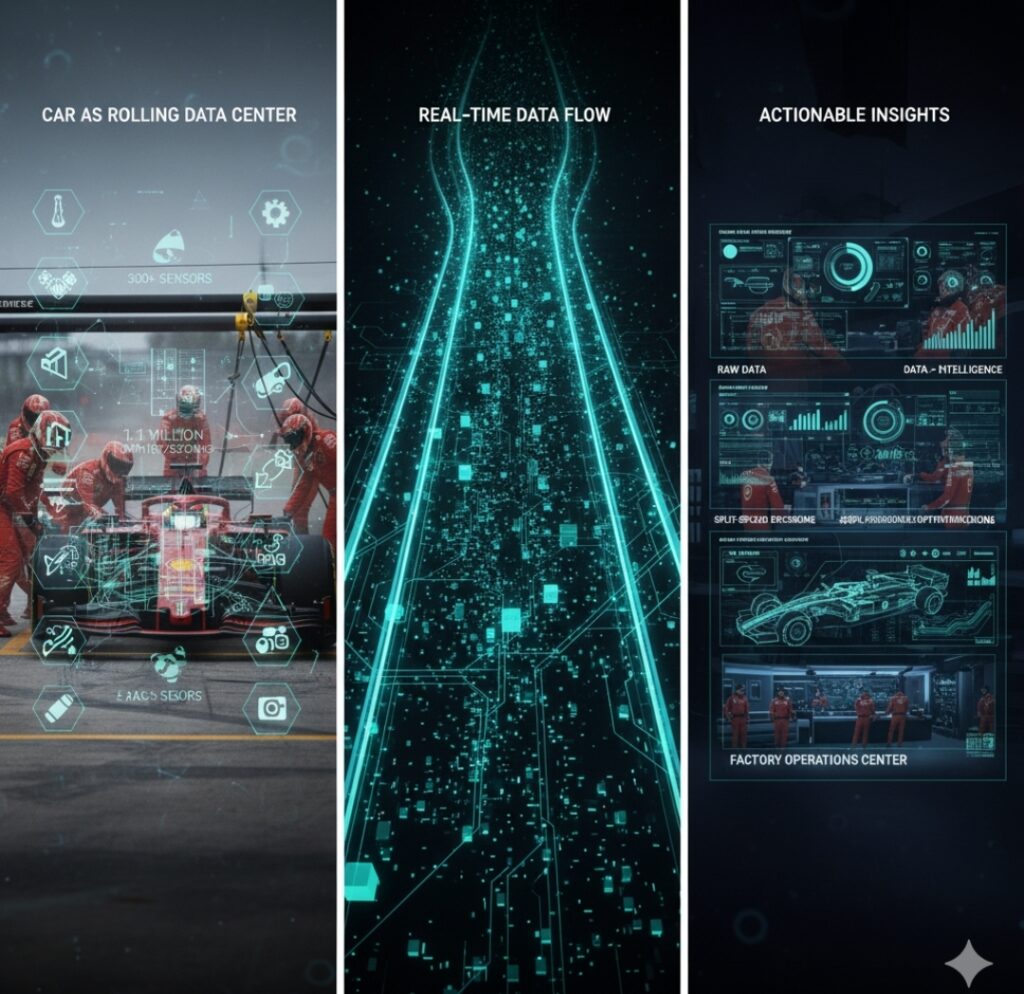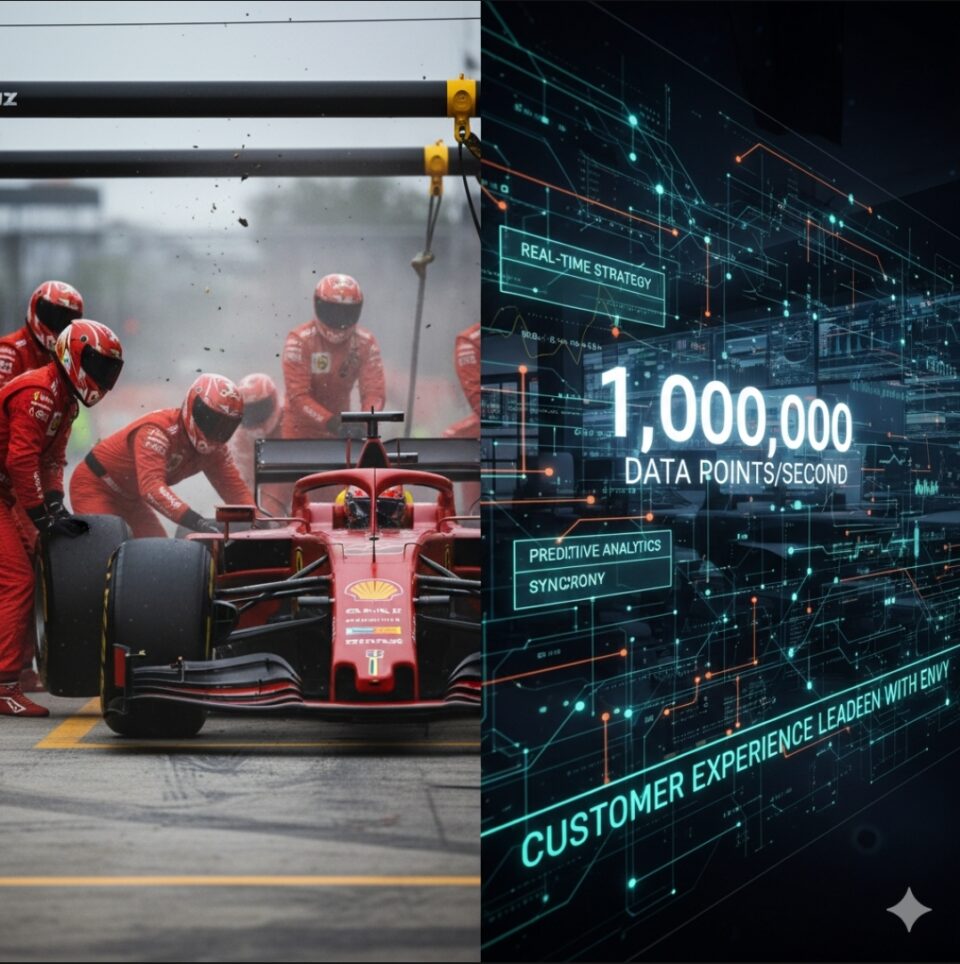When Speed Meets Strategy: How Formula 1’s Real-Time Data Revolution Is Transforming Customer and Employee Experience
Have you ever watched an F1 pit stop unfold in just 1.9 seconds and wondered how teams coordinate such perfect precision? The answer lies not in the wrench work, but in the data streams flowing at over one million points per second. Every tire change, every strategic call, every split-second decision emerges from real-time intelligence that would make most customer experience leaders green with envy.
This isn’t just about racing anymore. Confluent’s recent partnership with Visa Cash App Racing Bulls marks another milestone in Formula 1’s data-driven evolution, but more importantly, it signals a broader transformation happening across industries. When F1 teams can process massive data streams to optimize performance in real-time, the question becomes: why aren’t more businesses applying these same principles to transform their customer and employee experiences?
The F1 Data Engine: Million-Dollar Insights at 300 KPH
Every F1 car essentially operates as a rolling data center. With over 300 sensors generating more than 1.1 million data points each second, these machines create a continuous stream of performance intelligence that flows seamlessly between car, pit wall, and factory operations. What makes this remarkable isn’t just the volume—it’s the speed at which teams convert raw data into actionable insights.
Tim Goss, Chief Technical Officer of VCARB, captures this perfectly: “Every lap teaches us something new, and the faster we can learn, the better we get.” This learning velocity creates competitive advantage through three critical capabilities: immediate performance optimization during races, predictive analytics for strategic planning, and post-race analysis that informs next-generation vehicle development.
The Confluent partnership exemplifies this data-streaming approach, creating what Jay Kreps describes as “a central nervous system that connects car, pit wall, and factory.” This real-time data infrastructure doesn’t just decide race outcomes—it accelerates entire engineering cycles and streamlines complex logistics operations.
Real-Time CX: Racing Beyond Customer Expectations
F1’s data mastery offers powerful lessons for customer experience transformation. Teams must respond to changing conditions within milliseconds, much like businesses need to adapt to shifting customer needs in real-time. The parallels are striking and actionable.
Consider how F1 teams use predictive analytics to anticipate tire degradation and optimize pit stop timing. Customer experience leaders can apply similar approaches to predict customer satisfaction dips and intervene proactively. When BMW implemented real-time data streaming across their supply chain operations, they achieved immediate visibility into manufacturing processes, enabling faster bottleneck detection and resource allocation—principles directly transferable to customer service operations.
Disney+ demonstrates this CX application beautifully. Their real-time streaming platform ingests billions of events per hour using Amazon Kinesis Data Streams, processing this data to deliver personalized title recommendations and improve customer experiences. Just like F1 teams make split-second strategic decisions, Disney+ responds instantly to viewer behavior patterns to enhance engagement.
The business impact mirrors F1’s precision. One telecommunications provider leveraged AI-powered real-time analytics to achieve a 42% increase in first-call resolution rates and a 25% reduction in repeat calls within six months. These results emerged from applying F1-style data processing: unified data integration, predictive insights, and real-time decision support—exactly what racing teams use to optimize performance lap after lap.
Employee Experience: Pit Crew Precision for Workplace Performance
F1 pit crews exemplify seamless team coordination under extreme pressure. Their success stems from real-time data visibility, precise role definition, and continuous performance optimization—principles that directly translate to employee experience enhancement.
Modern workplace analytics mirror F1’s sensor-rich environment. Just as racing teams monitor everything from tire temperatures to fuel consumption, HR leaders can track space utilization, engagement patterns, and productivity metrics to create more responsive work environments. Eptura Engage demonstrates this approach, using real-time occupancy data and employee preferences to help leaders optimize office spaces and improve satisfaction scores.
The predictive element proves equally powerful. F1 teams use historical performance data to forecast optimal strategies for future races. Similarly, employee experience analytics can identify engagement patterns that predict turnover risks, enabling proactive interventions before dissatisfaction escalates. Organizations using AI-powered people analytics report success in detecting early morale shifts and stress points, allowing managers to address issues before they impact retention.
Confluent’s Formula 1 partnership showcases another EX lesson: the power of continuous learning loops. Racing teams analyze every data point to refine processes and enhance performance. Employee experience programs can adopt similar approaches, using pulse surveys and sentiment analysis to create rapid feedback cycles that drive workplace improvements in near real-time.
The Technology Stack: Building Your Data-Driven Performance Engine
F1’s technological infrastructure offers a blueprint for organizations seeking to transform their CX and EX capabilities. The key lies in architecting systems that can capture, process, and act on data streams with minimal latency.
Data streaming platforms like Confluent, Apache Kafka, and Amazon Kinesis provide the foundational layer for real-time processing. These systems separate data producers from consumers, enabling flexible architectures that can scale efficiently as data volumes grow. This decoupling proves crucial when building customer experience platforms that need to respond instantly to behavioral changes across multiple touchpoints.
The processing layer requires sophisticated analytics capabilities. F1 teams use machine learning algorithms to predict race outcomes and optimize strategies based on real-time conditions. Customer experience applications can leverage similar techniques for fraud detection, personalized recommendations, and predictive customer service. Financial institutions already demonstrate this approach, processing thousands of transactions per second to identify suspicious activities and prevent fraud in real-time.
Storage and visualization complete the stack. F1 teams need immediate access to both current race data and historical performance trends. Business applications require similar dual capabilities—real-time dashboards for immediate decision-making combined with comprehensive analytics for strategic planning. The key is ensuring data remains actionable rather than simply available.

Implementation Roadmap: From Pit Lane to Performance Lane
Organizations beginning their real-time transformation journey can learn from F1’s systematic approach to data-driven performance. The progression typically follows four phases: foundation building, pilot programs, scaling operations, and continuous optimization.
Foundation building focuses on data infrastructure and quality. F1 teams invest heavily in sensor accuracy and data transmission reliability because split-second decisions depend on precise information. Similarly, businesses must establish robust data collection and streaming capabilities before expecting meaningful insights. This includes implementing proper data governance, ensuring system integration, and building analytical capabilities.
Pilot programs allow for controlled experimentation. Racing teams test new strategies during practice sessions before implementing them during races. Customer experience leaders can adopt similar approaches by launching real-time analytics in specific channels or customer segments. Disney+ started with basic recommendation engines before expanding to their current billion-event processing capability.
Scaling operations requires careful attention to system performance and organizational change management. F1 teams gradually increase data processing complexity as their infrastructure and team capabilities mature. Business implementations should follow similar patterns, expanding real-time capabilities across additional touchpoints and use cases as confidence and competence grow.
Continuous optimization never ends in F1—teams constantly refine their approaches based on performance feedback. Customer and employee experience programs need similar commitment to iterative improvement, using real-time insights to enhance both technological capabilities and organizational processes.
Beyond the Checkered Flag: Measuring Success in Real-Time
F1’s measurement philosophy extends beyond simple lap times to encompass comprehensive performance optimization. Teams track hundreds of metrics across vehicle performance, strategic execution, and operational efficiency. This holistic approach provides valuable guidance for CX and EX measurement strategies.
Customer experience metrics should mirror F1’s multi-dimensional approach. First-call resolution rates, customer effort scores, and net promoter scores represent the equivalent of lap times—important indicators but insufficient alone. Real-time sentiment analysis, behavioral pattern detection, and predictive satisfaction modeling provide deeper insights that enable proactive improvements.
Employee experience measurement requires similar sophistication. Traditional engagement surveys represent historical data, much like reviewing last season’s race results. Real-time pulse surveys, workplace analytics, and predictive retention modeling offer the immediate insights needed for agile response to workforce dynamics. Organizations using advanced people analytics report significant improvements in identifying at-risk employees and addressing concerns before they impact performance.
The key lies in creating measurement systems that inform action rather than simply document results. F1 teams use real-time telemetry to make immediate race adjustments and strategic decisions. Business leaders need equivalent capabilities to respond rapidly to customer satisfaction changes and employee engagement fluctuations.
Racing Into the Future: The Competitive Advantage of Speed
Confluent’s partnership with VCARB represents more than sponsorship—it demonstrates how real-time data streaming becomes as fundamental to competitive advantage as traditional business capabilities. Organizations that master these technologies will outpace competitors still relying on batch processing and historical analysis.
The future belongs to businesses that can match F1’s learning velocity. Teams that process data at racing speeds while maintaining strategic focus will define new standards for customer and employee experience excellence. This isn’t just about technology adoption—it’s about embracing a fundamentally different approach to organizational intelligence and responsiveness.
Formula 1 proves that when speed meets strategy, extraordinary performance becomes possible. The question isn’t whether your organization will embrace real-time data streaming for CX and EX transformation—it’s how quickly you’ll cross that finish line ahead of your competition.
Key Takeaways for CX and EX Leaders:
Transform data infrastructure to support real-time processing and decision-making capabilities. Implement predictive analytics to anticipate customer and employee needs before issues arise. Build continuous feedback loops that enable rapid response to changing satisfaction patterns. Invest in integrated platforms that connect all touchpoints for comprehensive experience optimization. Establish measurement systems that drive immediate action rather than simply documenting historical performance.


